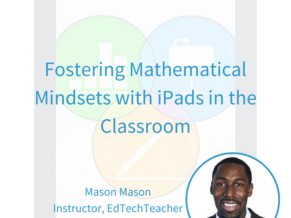Follow Mason on Twitter: @edtechmason
All students can learn math. Better yet, all students can love math. And even more importantly, all students can excel at math. And when classrooms go one-to-one with iPads, this enhances opportunities to foster the mathematical mindsets of students in the classroom. Carol Dweck and Jo Boaler believe math is the subject most in need of a mindset makeover, and I think integrating technology helps with that transformation.
Math class no longer has to be a traumatic experience for so many students (and their parents and teachers). This blog post is rooted in Jo Boaler’s (2016) book Mathematical Mindsets: Unleashing Students’ POTENTIAL Through Creative Math, Inspiring Messages and INNOVATIVE TEACHING. In this post, I suggest five ways to foster mathematical mindsets using iPads in the classroom based on the thoughts, theories, and pedagogies recommended by Boaler.
1- Pictures
Help students make relevant connections to mathematical concepts by photographically capturing the world around them using the iPad’s camera. Teach students to document patterns and appreciate the aesthetics, creativity, and beauty of the art of math. For example, allow students to take pictures of the spirals in flowers, pine cones, or pineapples to explore the Fibonacci sequence and the golden ratio. When students see that math is all around them, they begin to understand the role it plays in their lives.
2 Videos
Capturing video using the iPad’s camera is another powerful, and often overlooked, way to document math in the real world. Using the Slo-mo and Time-lapse features, students have the ability to drastically slow down or speed up video recordings, allowing them to analyze, synthesize, and critique film to better see math in action. Imagine using Time-lapse to record a spider weaving a web, water rising to the boiling point, or snow accumulating on the ground. Or using the Slo-mo to slow down a basketball shot, an egg dropped to the ground, or a chemical reaction. When students see math in action, they are better able to understand rate, speed, time, velocity, and more.
3 Screen Recordings
In mathematics, metacognition and reasoning are critical to a student's mathematical mindset. Two tools used together on the iPad that can help enhance metacognition and reasoning are Drawing and Screen Recording. While using any of the three apps in Apple’s iWork suite - Pages, Keynote, and Numbers - students can insert a Drawing into their document to work out math problems (tap the Insert button, tap the Shape button, then tap Drawing). Simultaneously, while working out the problem, they can use Screen Recording to capture their thinking (learn how to Screen Record on the iPad HERE). Students can share their recordings, and they can critique the reasoning of others. These processes increase engagement and enliven the mathematics classroom.
4 Shapes
Boaler recommends conceptual mathematical activities to help students learn numbers and number facts, and the iPad offers a variety of ways for students to engage in those types of activities. In the Pages, Keynote, and Numbers apps, there are more than 500 shapes and objects students can use as digital manipulatives, allowing students to visualize math concepts. Using shapes will help them better understand basic math functions and will also increase their spatial reasoning as they start to make connections to math facts. Brain science shows that when students make connections using these strategies, performing mathematical tasks is more accessible.
5 Clips
Reflection is often a critical component missing in mathematics instruction. To foster a mathematical mindset using the iPad, teachers can help students see that math is about thinking, sense-making, big ideas, and connections, and not just memorizing facts and steps. Clips lets students reflect on their learning using pictures, videos, posters, filters, graphics, and more. Instead of assigning more problems for homework, consider assigning a reflection question for students to answer. This will help students think conceptually about big ideas and encourages self-reflection. More importantly, these Clips can be used by teachers as formative assessment that helps guide their instruction.
Feedback
Math teachers often struggle with effectively integrating iPads into their math instruction. Hopefully, these strategies will not only help you begin to transform teaching and learning in your mathematics classroom, but will also help foster a mathematical mindset in your students, leading to a greater appreciation of mathematics and higher levels of achievement.
In what ways are you fostering a mathematical mindset in your classroom using iPads? I’d love to hear your stories and feedback on Twitter. You can connect with me at EdTechMason.


